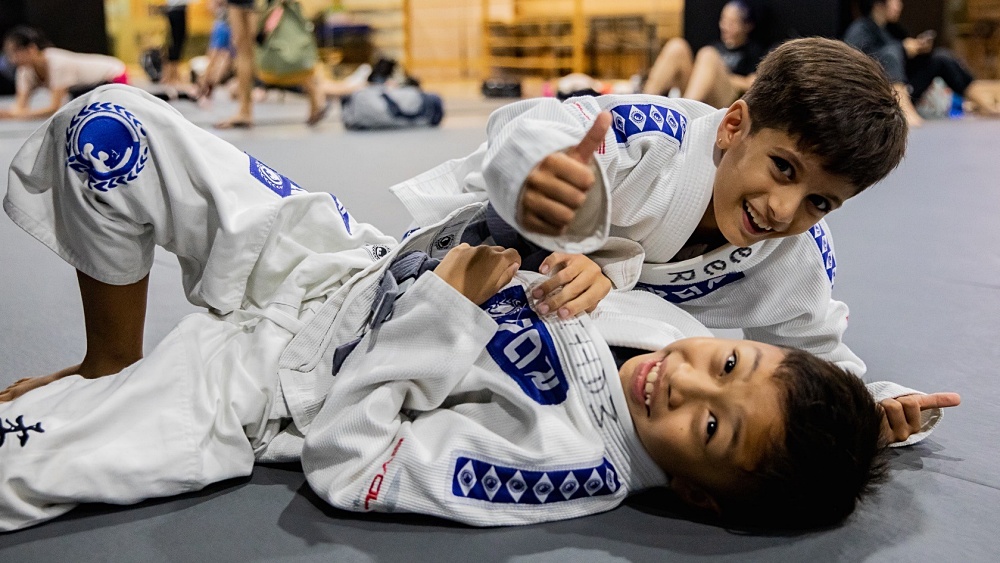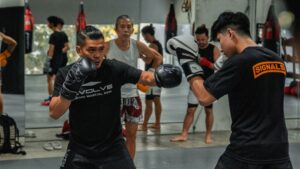There has always been a bit of a rivalry between Brazilian Jiu-Jitsu (BJJ) and judo, two of the major grappling-based martial arts. With there being similarities between the two martial arts, many BJJ players have found success in incorporating judo techniques into their arsenal. Having an extra set of tools that your opponent might not have could potentially lead to more success. Today, Evolve Daily has put together a list of some of our favorite judo techniques that can be utilized in pure BJJ.
1) The Clock Choke
While many Brazilian Jiu-Jitsu practitioners look to judo for throwing techniques, there are also some very effective mat work techniques that can be converted over. While the ruleset of modern judo prohibits a lot of the submissions we see in BJJ, straight armlocks and chokes are still permitted. Due to the fact that in judo submissions must be executed quickly before the ref calls for a standup, judo players have to be able to attack the few submissions they are allowed aggressively if they want to submit their opponent. This combination of only being allowed to choose from a few select submissions, and having to implement those submissions at an incredibly fast pace, has created a scenario in which the technique has to be perfect in order for it to lead to victory. For this reason, BJJ players should look to their judo colleagues not only for awesome throws and trips but for insight into how to perform judo’s classic submissions, such as the Clock Choke.
The Clock Choke is perhaps one of the most vicious strangleholds in all of gi grappling. Much like the Bow and Arrow Choke, the Clock Choke utilizes the entirety of the attacker’s body against only the neck of the defender. The Clock Choke is usually set up from the Turtle position. If you are on the right side of your opponent’s body, thread your right arm underneath your opponent’s chin and grab his far side lapel, in the same grip that you would use for a gi choke from the back. Now you will choose which variation of the Clock Choke you want to utilize. Depending on which grip is available to you, your non-choking arm (the left arm in this scenario) can either thread under your opponent’s left armpit and secure the wrist, or go over your opponent’s back to grab the inside of his left thigh. While gripping the wrist is more secure, the leg grip will allow you to pull yourself into the choke, creating a much more effective strangle.
Once you’ve secured your grip, place your forehead on the ground next to your opponent’s and walk your legs in a circle around your opponent’s head to apply the strangle. Your legs should look like the hands moving around the clock, hence the name “Clock Choke.”
2) Sumi Gaeshi
While the modern ruleset of judo has led to a decline in the usage of Sumi Gaeshi, the rules and techniques of BJJ competition have created a style of grappling where the Sumi Gaeshi fits in nicely. Before the rules of judo banned touching the lower body, takedowns such as double and single legs were quite prominent. One counter judokas would use to defeat these wrestling-based takedowns was the Sumi Gaeshi. As these wrestling takedowns are no longer permitted we don’t see this counter very often in judo, but it still works very well in both gi and no-gi BJJ.
One of the most popular takedown techniques in BJJ is the single leg takedown. While the single leg is an incredibly powerful means of taking an opponent to the mat, the bent-over nature of the move provides the defender with the ability to counter, especially with the Sumi Gaeshi. If your opponent decides to shoot in for a single leg and is successful in getting your foot off of the mat, the first thing you want to do is maintain your balance and attempt to pull his hands off of your leg. This will help delay the takedown. Then take the hand that is on the same side as the captured leg and grab your opponent’s belt with your palm up. As you pull your opponent on top of you with this grip, sit down and slide underneath your opponent as you use your captured leg as a butterfly hook to throw your opponent onto his back, taking top position. If you are grappling without the gi, the Sumi Gaeshi can be done with either a figure four Kimura grip or a Guillotine Choke. While the mechanics of the throw are the same, make sure you practice each grip as they are slightly different.
3) The Sankaku (Triangle Choke)
While most Brazilian Jiu-Jitsu practitioners are familiar with the Front Triangle Choke that we see utilized from the Guard, they may be surprised to learn that judo has all different versions of the Triangle Choke that are implemented from a variety of top positions. The Sankaku, as the Triangle Choke is called in judo, is usually implemented from the Turtle position or Side Control. Because in judo a pin can be used to win the match, Sankakus are typically used to hold the opponent on his back for the time required to secure the pin and win the match.
While pins aren’t a way to win in BJJ, submissions are. If you find yourself in top Side Control, a great method of simultaneous control and submission is to use the Sankaku. Push the nearest of your opponent’s arm between your legs as you step over his head, trapping his arm and head in the Triangle. As you squeeze with your legs to apply the strangle, you can also attack the free arm with a joint lock. The best way to do this is with a Kimura, but the Straight Arm Lock and the Americana are also viable options.
One of the biggest mistakes BJJ practitioners make that hinders their progress is failing to explore a vast array of techniques to find which ones work for them. While the rules and techniques differ slightly, judo and Brazilian Jiu-Jitsu are both realistic gi grappling arts that have numerous similarities.
















